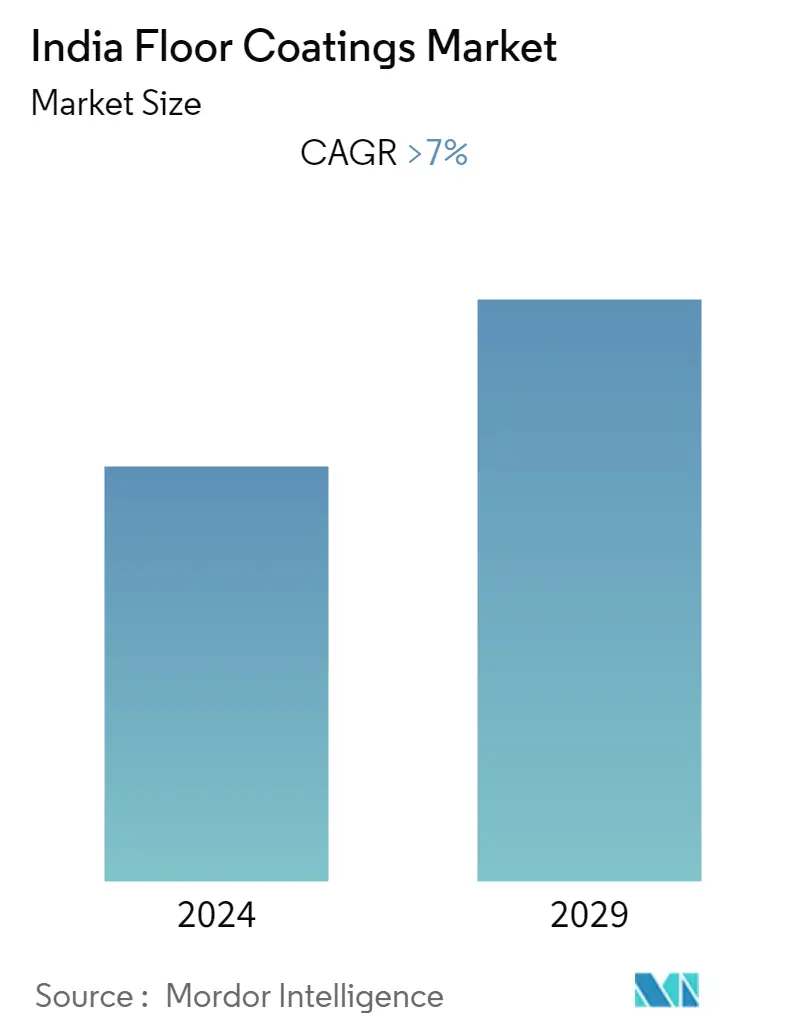Market Size of India Floor Coatings Industry

| Study Period | 2019 - 2029 |
| Base Year For Estimation | 2023 |
| Forecast Data Period | 2024 - 2029 |
| Historical Data Period | 2019 - 2022 |
| CAGR | > 7.00 % |
| Market Concentration | Medium |
Major Players
*Disclaimer: Major Players sorted in no particular order |
India Floor Coatings Market Analysis
The India Floor Coatings Market was worth USD 1090 million at the end of the year, and it is expected to register a CAGR of 7% during the forecast period. Because construction stopped all over the country because of the COVID-19 pandemic, it hurt the market. But after COVID-19, the country went back to building homes and businesses, which will help the market recover in the coming years.
- In the short term, rising residential and commercial construction activities in India will likely drive the market.
- On the other hand, traditional floor coatings are bad for the environment, which slows the growth of the market.
- In the market that was looked at, most of the demand for floor coatings came from the industrial sector, and this demand is expected to grow as the chemical industry grows.
- Polyaspartic coatings are likely to have a chance in the future because of how well they work.
India Floor Coatings Industry Segmentation
Floor coatings are durable, protective layers applied to surfaces subjected to extreme wear or corrosion. Warehouses, chemical plants, and production floors are examples of typical applications. The market is segmented by product type, floor material, and end-user industry. By product type, the market is segmented into epoxy, polyaspartics, acrylic, polyurethane, and other product types. By floor material, the market is segmented into wood, concrete, and other floor materials. By end-user industry, the market is segmented into residential, commercial, and industrial. The report offers market size and forecasts in terms of revenue (USD million) for all the above segments.
| Product Type | |
| Epoxy | |
| Polyaspartics | |
| Acrylic | |
| Polyurethane | |
| Other Product Types |
| Floor Material | |
| Wood | |
| Concrete | |
| Other Floor Materials |
| End-user Industry | |
| Residential | |
| Commercial | |
| Industrial |
India Floor Coatings Market Size Summary
The India floor coatings market is poised for significant growth, driven by the resurgence of construction activities in both residential and commercial sectors post-COVID-19. The market, which faced setbacks due to the pandemic, is expected to recover as the country continues to build homes and businesses. The residential construction segment is particularly buoyant, fueled by factors such as population growth, urban migration, and the trend towards nuclear families. Government initiatives like the 'PM Aawas Yojana' and investments in smart city developments are further propelling the demand for floor coatings. However, environmental concerns related to traditional floor coatings pose challenges to market expansion. Despite these challenges, the industrial sector remains a dominant force in the market, with increasing demand from industries such as chemicals, automotive, and food and beverages, which require durable and chemical-resistant flooring solutions.
The industrial segment's dominance is underscored by its critical role in sectors that demand high-performance flooring for safety, hygiene, and aesthetic purposes. The chemical industry, in particular, is a major end-user, necessitating robust floor coatings to protect against chemical stains and ensure worker safety. The market is characterized by a partial consolidation, with key players like Akzo Nobel N.V., Asian Paints, and Berger Paints India Limited leading the charge. Innovations such as polyaspartic coatings are emerging as potential growth areas, offering advanced performance characteristics. As India continues to urbanize and invest in infrastructure, the floor coatings market is expected to experience sustained growth, supported by both government initiatives and private sector investments.
India Floor Coatings Market Size - Table of Contents
-
1. MARKET DYNAMICS
-
1.1 Drivers
-
1.1.1 Growing Awareness about the Advantages of Floor Coatings
-
1.1.2 Increasing Construction Activities in India
-
-
1.2 Restraints
-
1.2.1 Harmful Environmental Impact of Conventional Coatings
-
-
1.3 Industry Value-Chain Analysis
-
1.4 Porter's Five Forces Analysis
-
1.4.1 Bargaining Power of Suppliers
-
1.4.2 Bargaining Power of Buyers
-
1.4.3 Threat of New Entrants
-
1.4.4 Threat of Substitute Products and Services
-
1.4.5 Degree of Competition
-
-
-
2. MARKET SEGMENTATION (Value in USD Million)
-
2.1 Product Type
-
2.1.1 Epoxy
-
2.1.2 Polyaspartics
-
2.1.3 Acrylic
-
2.1.4 Polyurethane
-
2.1.5 Other Product Types
-
-
2.2 Floor Material
-
2.2.1 Wood
-
2.2.2 Concrete
-
2.2.3 Other Floor Materials
-
-
2.3 End-user Industry
-
2.3.1 Residential
-
2.3.2 Commercial
-
2.3.3 Industrial
-
-
India Floor Coatings Market Size FAQs
What is the current India Floor Coatings Market size?
The India Floor Coatings Market is projected to register a CAGR of greater than 7% during the forecast period (2024-2029)
Who are the key players in India Floor Coatings Market?
Akzo Nobel N.V., Asian Paints, Berger Paints India Limited, Kansai Nerolac Paints Limited and Nippon Paint Holdings Co. Ltd are the major companies operating in the India Floor Coatings Market.

